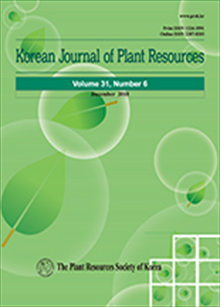간행물
한국자원식물학회지 KCI 등재 Korean journal of plant resources

- 발행기관 한국자원식물학회
- 자료유형 학술지
- 간기 격월간
- ISSN 1226-3591 (Print)2287-8203 (Online)
- 수록기간 1988 ~ 2020
- 주제분류 농수해양 > 농학 농수해양 분류의 다른 간행물
- 십진분류KDC 520DDC 630
권호리스트/논문검색
Vol.3 No.1 (1990년 3월) 5건
1.
1990.03
서비스 종료(열람 제한)
The traditional plant imprownent methods consisted of pure line selection, cross breeding, heterosis breeding, polyploid breeding, mutati-onbreeding, ect.Biotechmoiogy is divided into gene spliclng , monocle-nal antibodies , protein engineering , agricultural research, and microbiological engineering. Of these , high plants deal with agricultural research, and the importent part of which is tissue culture and celLculture , Tissue .culture and cell culture are again divided into embryoculture, test tube fertilization, anther and pollen culture, somatichybridization , transformation, recombination, recombinant DNA moleculehybrid plasmid, ect For these haploid production, protoplast culture,protoplast fusion, selection and propagation, ect. , the technical sett-lement is needed.
2.
1990.03
서비스 종료(열람 제한)
Pericarp and seedcoat removal treatments were tested to determine their effectiveness in the hard-to-germinate botanical seeds of jerusalem artichoke. Fresh seed of five Helianthus tuberosus L.varieties were (A)untreated (B)water soaked overnight (C) soaked overnight followed by renoval of pericarp or (D) soaked overnight followed by renoval of pericarp and seedcoat. The results indicate that treatments which removed the pericarp and seedcoat were the very effective, giving germination of over 90%. A considerable increase in germination did not follow only the peri-carp removal treatments. The factors inhibitory to germination of fresh jerusalem artichoke seed is associated withthe seedcoat. The removal treatment of pericarp and seed-cost is recommended despite its complexity because it givesa high germination percentage and varies least from varietyto variety. Heliarthus tuberosus L., a biomass potential crop, is a member of the family compositae. The genus Helianthushas provided man with two food plants, the sunflower (H.annus) and the jerusalem artichoke or topinambour (H. tube-rosus) . (3) The jerusalem artichoke grown for its tubers, has always been an extremely minor crop, but it is stillgrown in many places as a food for man or livestock and forthe production of alcohoL. Though tubers are used for pro-pagation jerusalem artichoke also flower and produce seedin head-like in florescences. Flowers are developed acro-petaLly on flattened receptacles such that outermost flowers are oldest. Each of these epigynous flowers may develop an achene-type fruit in which outer layers of the overy wallpersist, while inner layers become disorganized. Insidethe ovary wall of mature fruit, there is a papery seedcoat, probably composed of compact cells from endosperm, integu-ments, and nucellus.In general, the efforts to improving this crop havebeen hampered by the hard-to-germinate botanical seed.Seeds did not germinate for at least IL months after harvest.Fresh seeds of some varieties require one year more to gar-minate. (5) Since the time factor between generations isof concern in a prospective breeding program of jerusalemartichoke , these observations led to investigation of thenature of delayed seed germination in jerusalem artichokeas a biomass potential crop.
3.
1990.03
서비스 종료(열람 제한)
추월산 지역에 분포되어 있는 한약 자원식물을 채집 분류하여 이용체계 확립의 수단으로 삼고자 이 지역의 약용식물의 종류를 조사한 결과는 다음과 같다. 1. 추월산에 분포되어 있는 약용자원 식물은 113 과, 304 속, 428 종이었다. 2. 분포수종중 초본류는 73 과, 223 속, 317 종, 목본류는 49 과, 85 속, 111 종이었다. 3. 초본류는 주로 전초 또는 근을, 목본류는 수피, 과실이 한약재료로 많이 사용되어지는 것이었다.
4.
1990.03
서비스 종료(열람 제한)
The physicochemical activities of the underground parts of Roso rugosa Thunb (Rosaceae) , which have been used as an antidiabetic in the folkmedicines of Korea , was carried outThe methanol extract from this plant reduced serum Lipid Level the normal rat . When various fractions from the methanol extract was administered to the rat treated with 1% choholesterol and 0.5% cholic aciddiet , the ethyl acetate soluble fraction lowered the serum triglycerideand phospholipid level most remarkably
5.
1990.03
서비스 종료(열람 제한)
To evaluate the mineral value , 27 samples of the wild Codomopsis Lanceolate used for herbs and sidedish were analyzed . All C.Lance-olate, though they inhabit in various zones , contain 21minerals inthe leaf , shoot and root. The richest mineral contained in the C.Lanceolate was noticed to be K. and folLowed by Mg, Ca and p. Thecontent of K.Mg, Ca .p and Fe is higher in the leaf than in theshoot and root. The content of mineral value is quite variousaccording to the geographical difference .

